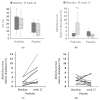Prebiotic Treatment in Patients with Nonalcoholic Fatty Liver Disease (NAFLD)-A Randomized Pilot Trial
- PMID: 38892505
- PMCID: PMC11174003
- DOI: 10.3390/nu16111571
Prebiotic Treatment in Patients with Nonalcoholic Fatty Liver Disease (NAFLD)-A Randomized Pilot Trial
Abstract
Several studies show that gut microbiotas in patients with nonalcoholic fatty liver disease (NAFLD) differ from those in a healthy population, suggesting that this alteration plays a role in NAFLD pathogenesis. We investigated whether prebiotic administration affects liver fat content and/or liver-related and metabolic parameters. Patients with NAFLD and metabolic syndrome (age: 50 ± 11; 79% men) were randomized to receive either 16 g/day of prebiotic (ITFs-inulin-type fructans) (n = 8) or placebo (maltodextrin) (n = 11) for 12 weeks. Patients were instructed to maintain a stable weight throughout the study. Liver fat content (measured by H1MRS), fecal microbiota, and metabolic, inflammatory, and liver parameters were determined before and after intervention. Fecal samples from patients who received the prebiotic had an increased content of Bifidobacterium (p = 0.025), which was not observed with the placebo. However, the baseline and end-of-study liver fat contents did not change significantly in the prebiotic and placebo groups, neither did the liver function tests' metabolic and inflammatory mediators, including fibroblast growth factor-19 and lipopolysaccharide-binding protein. Body weight remained stable in both groups. These findings suggest that prebiotic treatment without weight reduction is insufficient to improve NAFLD.
Keywords: NAFLD; fibroblast growth factor; lipopolysaccharide; microbiota; prebiotic.
Conflict of interest statement
The authors declare no conflict of interest.
Figures





References
Publication types
MeSH terms
Substances
LinkOut - more resources
Full Text Sources
Medical

